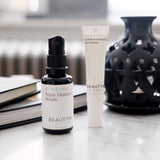
Throughout your lifetime, your skin is in a constant state of cell turnover. Your outer layer of skin cells serve their purpose to protect your skin, die, and then are replaced by new, healthy skin cells your body creates. And then the process repeats itself.
While this process will occur naturally, there's nothing wrong with providing your skin with a little boost through exfoliation. Not to mention that, as you age, your skin's natural rate of skin cell turnover starts to slow down. This slowing can result in rough, dull, discolored, and large-pored skin. The cell turnover process can slow as early as age 30, meaning no one is really too young (or too old) to think about exfoliating products.
The challenge then becomes to choose the right exfoliating products for your skin. Spoiler Alert: The answer is a chemical exfoliant containing glycolic acid. To see how we reached this conclusion, consider the factors of physical vs. chemical exfoliation, plus exfoliation strength.
Chemical vs. Physical Exfoliation
When it comes to exfoliation, you have two options: physical exfoliation, which means utilizing a skin scrub to manually remove dead skin cells, and chemical exfoliation, which means applying an acid-containing product to your face and allowing these acids to do the exfoliating job for you.
For dermatologists like Dr. Schultz, chemical exfoliation is considered the best option for patients. Several reasons for this conclusion exist. First, physical exfoliation is difficult to consistently perform. You may feel like you are scrubbing your skin uniformly, yet may be pressing too hard on some areas and not enough on others. Also, physical exfoliation can be too harmful to the skin because too-rough exfoliating products can create micro-tears in the skin, causing irritation.
In contrast, chemical exfoliation utilizes the beneficial effects of enzymes and/or acids, such as glycolic acid to break the bonds between dead skin cells and new ones. Dull, dry skin cells are allowed to fall away and leave behind new, fresh cells. This level of exfoliation is a controlled one because glycolic acid can be prepared (buffered) in such a way that it targets needed areas without irritating your skin. While there are many chemical exfoliating ingredients available on the market, glycolic acid is considered the gold-standard for exfoliation. The next section gets deeper into why, so keep reading.
The Right Size Molecules
Alpha hydroxy. Beta hydroxy. Enzyme exfoliant.
There are many exfoliating products available on the market for your skin. Glycolic acid belongs to the alpha hydroxy acid (AHA) family and is derived from sugar cane. Of all the AHAs available for cosmetic use, glycolic acid has the smallest molecules. For this exfoliating vehicle, size does matter. The smaller molecules can more effectively penetrate pores, break up the glue-like bonds that hold dead skin cells to your face and reveal healthier skin.
Therapeutic Range
A common problem in choosing the right exfoliating product for your skin is where to start in terms of strength of a chemical exfoliant. You don't run a marathon the first time your feet pound the pavement—so it makes sense that your skin probably isn't ready to start out at the highest-strength exfoliating product.
However, over time, you can increase your product's strength. Just like a muscle, your skin becomes used to a certain strength over time. To increase your results, you must increase your chemical strength.
This fact brings another reason why glycolic acid is the best exfoliating product for your skin. Compared with other chemical exfoliants, glycolic acid has the widest therapeutic margin. At-home glycolic acid exfoliants can contain concentrations ranging from 1 to 20%. Compare this to another chemical exfoliant, the beta hydroxy acid salicylic acid, which is offered in concentrations ranging from 0.5 to 2.0%.
Having a wide therapeutic range means your exfoliating products have somewhere to go: up, and this increase allows you to experience greater benefits. Dr. Schultz incorporates this concept into BeautyRx's The Progressive Peel. This at-home glycolic peel increases in concentration over the course of a six-week application, taking the guesswork out of when and how you should increase your exfoliant's concentration.
Resources:
Beta hydroxy acids. (2014, March 9). Retrieved from http://www.fda.gov/Cosmetics/ProductsIngredients/Ingredients/ucm107943
Burgess, C. (ed.). (2005). Cosmetic Dermatology. Springer.
Exfoliating 101: How to let fresh, radiant skin shine through. (2008, February 22). Health. Retrieved from http://www.health.com/health/article/0,,20410841,00.html
Schultz, N. (2009, August 18). The difference between glycolic and salicylic acid. Retrieved from http://www.dermtv.com/difference-between-glycolic-and-salicylic-acid
Schultz, N. (2012, November 19). Glycolic acid. Retrieved from http://dermtv.com/glycolic-acid
 BRX REWARDS
BRX REWARDS






















Leave a Comment